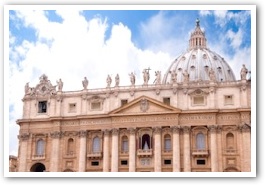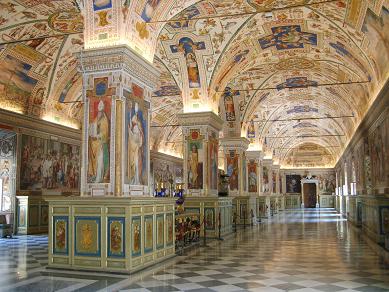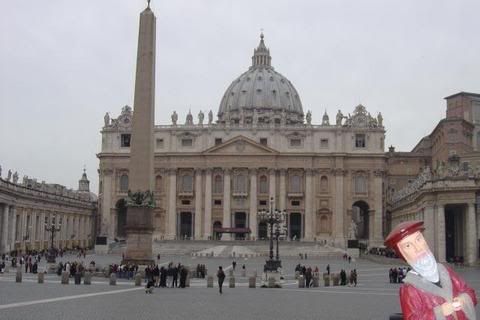
Posted on 01/12/2015 11:59:16 AM PST by NYer
Freedom of speech is a great thing. Unfortunately, it comes at an unavoidable price: When citizens are free to say what they want, theyll sometimes use that freedom to say some pretty silly things. And thats the case with the 12 claims were about to cover.
 |
Some of them are made over and over, others are rare. Either way, while the proponents of these errors are free to promote them, we as Catholics have a duty to respond.
6. "If the Church truly followed Jesus, they'd sell their lavish art, property, and architecture, and give the money to the poor."
When some people think of Vatican City, what they immediately picture is something like a wealthy kingdom, complete with palatial living accommodations for the pope and chests of gold tucked away in every corner, not to mention the fabulous collection of priceless art and artifacts. Looking at it that way, it's easy to see how some people would become indignant at what they think is an ostentatious and wasteful show of wealth.
But the truth is something quite different. While the main buildings are called the "Vatican Palace," it wasn't built to be the lavish living quarters of the pope. In fact, the residential part of the Vatican is relatively small. The greater portion of the Vatican is given over to purposes of art and science, administration of the Church's official business, and management of the Palace in general. Quite a number of Church and administrative officials live in the Vatican with the pope, making it more like the Church's main headquarters.
As for the impressive art collection, truly one of the finest in the world, the Vatican views it as "an irreplaceable treasure," but not in monetary terms. The pope doesn't "own" these works of art and couldn't sell them if he wanted to; they're merely in the care of the Holy See. The art doesn't even provide the Church with wealth; actually, it's just the opposite. The Holy See invests quite a bit of its resources into the upkeep of the collection.
The truth of the matter is that the See has a fairly tight financial budget. So why keep the art? It goes back to a belief in the Church's mission (one of many) as a civilizing force in the world. Just like the medieval monks who carefully transcribed ancient texts so they would be available to future generations — texts that otherwise would have been lost forever — the Church continues to care for the arts so they will not be forgotten over time. In today's culture of death where the term "civilization" can only be used loosely, the Church's civilizing mission is as important today as it ever was.
In Matthew 26:6ff we read,
A woman came up to him with an alabaster jar of very expensive ointment, and she poured it on his head as he sat at table. But when the disciples saw it, they were indignant, saying, "Why this waste? For the ointment might have been sold for a large sum and given to the poor." But Jesus, aware of this, said to them, "Why do you trouble the woman? For she has done a beautiful thing to me. For you always have the poor with you, but you will not always have me."
Likewise, many of the great cathedrals of Europe were built with donations and labor from the poor, who wanted to build such monuments to God’s goodness and sovereignty. The Vatican does not control enormous liquid wealth, and its annual operating budget has been compared to that of a large archdiocese such as that of Chicago.
In spite of this, the Catholic Church is still one of the most giving institutions on earth, running and supporting countless charities, relief organizations, hospitals, and similar enterprises at great cost to the Church. Ref
Ping!!
I’m not Catholic, but this has in general always seemed a poor argument to me.
In the past, high churchmen often led lavish lives. As great aristocrats of the Church they expected to live similar to great secular aristocrats. And they did.
Possibly I’m just ill-informed, but I don’t believe this is as much the case as it used to be a few centuries ago.
The Church owns real estate in cities worth enormous sums. Much of it is in churches and cathedrals, which don’t exactly have a whole lot of alternative uses.
It is, IMO, debatable whether the Church should have spent such immense sums on art and architecture. Is that part of its mission?
I know Jesus. And Rome ain't Him.
Kind of a self inflicted wound.
Poor Rome, has to spend all this money to upkeep it's priceless art collection. (And for 16 Euros you can see it all for yourself!)
Those churches are not owned by the Church. They were built by locals with their own resources. Trust me on this one ... because I have just gone through the process. Our parish purchased a former Methodist/Episcopal church that was closed and shuttered. The church had been sold to a local family on condition that it never be resold for commercial use. We used our own funds to acquire the church and our own funds to restore it. The Church gave us nothing.
Insofar as the artwork, much of it was gifted to the Church. The Church acts a a guardian. Artwork is maintained through other resources, such as Vatican Patrons.
As stated, in general I agree.
#13
If baby baptism is legit for all Catholics, why isn’t at least one specific baby baptized in the New Testament?
**The pope doesn’t “own” these works of art and couldn’t sell them if he wanted to; they’re merely in the care of the Holy See. The art doesn’t even provide the Church with wealth; actually, it’s just the opposite. The Holy See invests quite a bit of its resources into the upkeep of the collection.**
So many are misguided in their judgments about sacred art.
Whole households were baptized. Lydia’s for example by Paul. Although infants are not mentioned in Scripture directly, undoubtedly their were very young children or babies.
“Kind of a self inflicted wound.”
No wound at all.
“If baby baptism is legit for all Catholics, why isn’t at least one specific baby baptized in the New Testament?”
It must be one the same page that the inspired Table of Contents is on.
Luke 18:15-16
On the other hand, nowhere do we read of children raised in believing households reaching the age of reason and then being baptized. The only explicit baptism accounts in the Bible involve converts from Judaism or paganism. For children of believers there is no explicit mention of baptism—either in infancy or later.
Gee. I wonder why.......


Assumptions are pretty poor things to make doctrine about.
Quite a bit of the artwork was given as gifts by various people/ groups/ countries. I personally would not mind if they sold some of it, but how do you decide which to sell. I might feel a bit insulted if i gave them a Picasso and they sold that but kept the Dali that my sister gave them.
In regard to the architecture Look in the Bible at the description of the Ark, the vestments, and the Temple.
They gave the very best they had when they picked the animals to sacrifice. The other offerings they gave were the first fruits, the very best they had.
Why would we do any different?

I am somewhat conflicted about this issue. But I don’t see a direct parallel between the Ark and Temple of Judaism and the church buildings of Christ.
Jesus lived quite a humble life, and immense pageantry and display in His service don’t seem to me entirely appropriate.
yep
Disclaimer: Opinions posted on Free Republic are those of the individual posters and do not necessarily represent the opinion of Free Republic or its management. All materials posted herein are protected by copyright law and the exemption for fair use of copyrighted works.